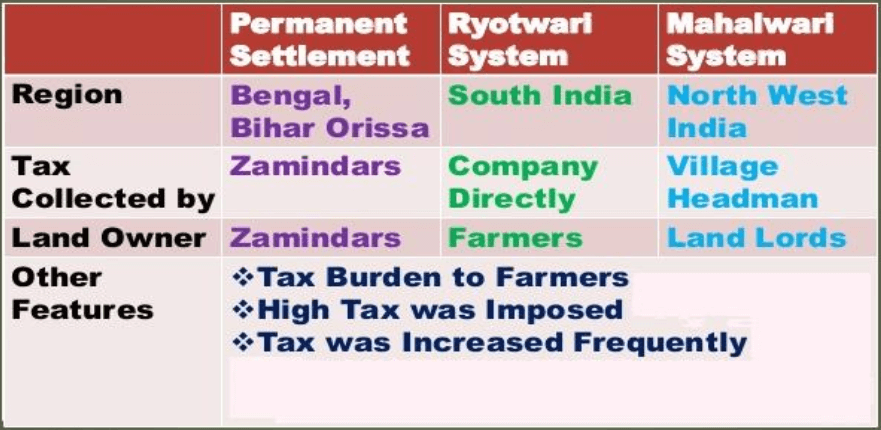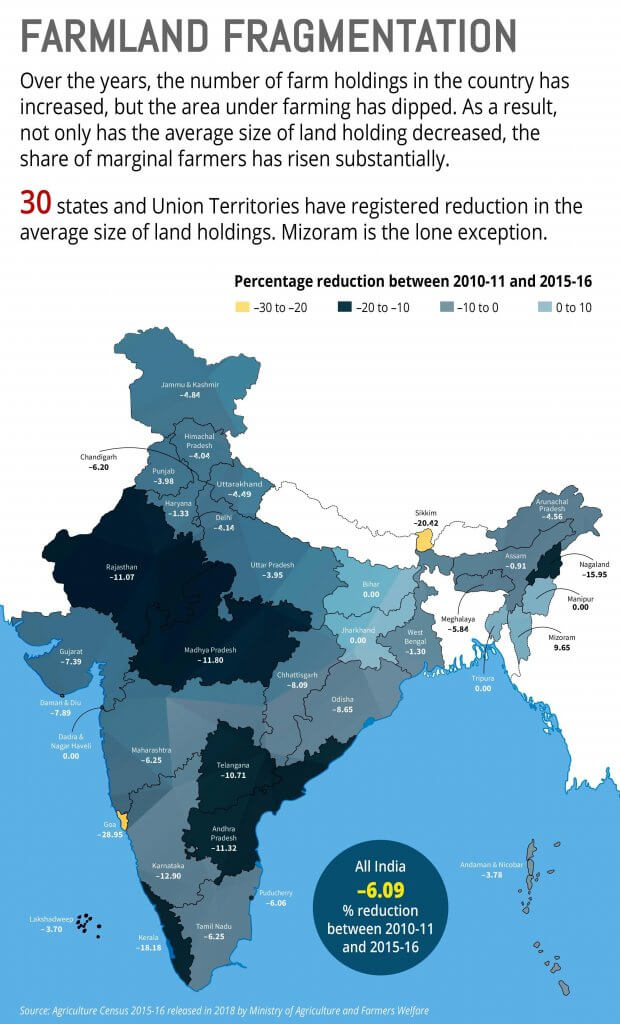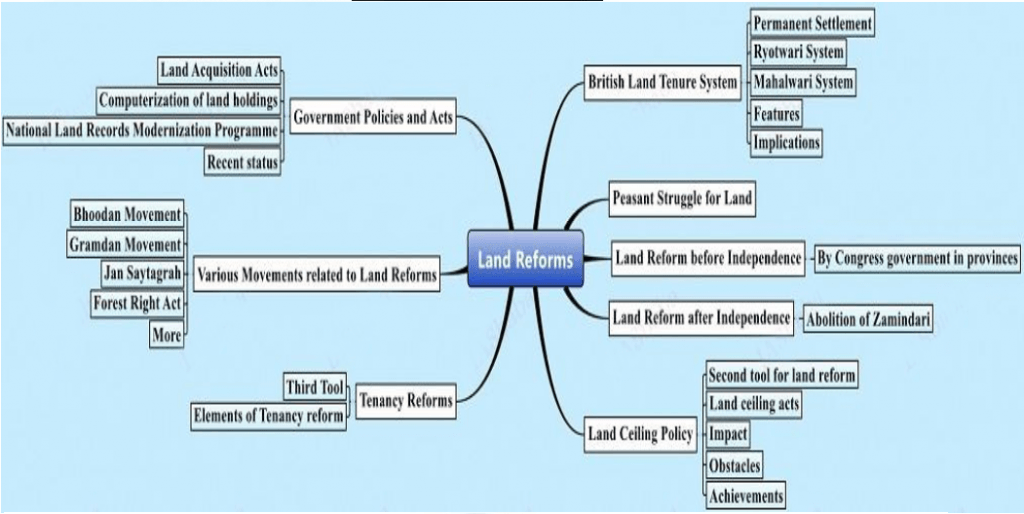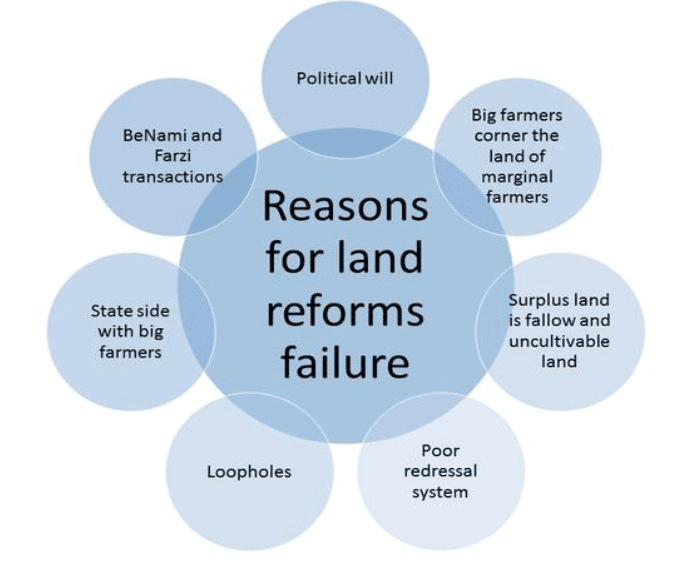Land Reforms since Independence
- Land Reforms is a planned and institutional reorganization of the relation between man and land i.e. changes introduced into the system of land tenure and the farming structure.
- Objectives of Land Reforms:
- Restructuring of agrarian relations to achieve an egalitarian structure
- Elimination of exploitation in land relations
- Actualization of the goal of “land to the tiller”
- Increasing agricultural production and productivity.
- The measures adopted to achieve the above objectives included the abolition of intermediaries between the state and tenants, tenancy reforms, fixation of ceiling on land holdings, and consolidation of holdings.
- “Land” falls under the state list (as per the Seventh Schedule of the Constitution), Hence state legislatures have to enact the land reforms related legislation. Therefore, there is no uniformity in land reforms across India (Different states have different provisions).
Zamindari Abolition
- Before Independence, three major types of land tenure systems existed in India: Zamindari, Mahalwari, and Ryotwari.
- In Zamindari system, the British government outsourced the land Revenue collection work to Zamindars. These ‘intermediaries’ would:
- Force the tenants to provide demand free labour (Begari)
- Evict tenants as per their whims and fancies i.e. no tenure security.
- Legislations were passed by the states to abolish such intermediaries. The first such legislation was enacted in Madras in 1948.
- Provisions of Zamindari Abolition Acts:
- Ownership and land revenue related rights of the Zamindars were abolished.
- Lands transferred to the (superior) tenants.
- State governments gave compensation to Zamindars.
- Transferred the ownership of common land/resources (previously held by Zamindars) to village Panchayat.
- Land which was cultivated by the Zamindar himself was exempted from purview of these acts. Zamindar was permitted to keep this land.
- Farmer was made directly liable for paying land revenue to the state government (Because Zamindar is no longer the ‘middleman’ in land revenue hierarchy).

Achievements of Zamindari Abolition
- 1,700 lakh hectares of land was acquired from the intermediaries (Zamindars) and as a consequence, about two crore tenants were brought into direct relationship with the government.
- May millions of cultivators who had previously been weak tenants or tenants-at will became superior tenants.
- Many absentee landlords started direct ‘personal cultivation’ so the state cannot take away their land.
- The entire process occurred in a democratic framework unlike the land reforms in China, Russia or Cuba.
- Changed rural power structure: This disarmed the Zamindars of economic exploitation and dominance over others. Thus, transferred power from Zamindars to peasants.
- Rise of middle class.
Limitations of Zamindari Abolition:
- After the laws were passed, Zamindars went to the courts for stay on the law implementation which greatly reduced the effectiveness of these legislations.
- Personal cultivation – Many states permitted Zamindars to keep a part of their land for personal cultivation but the vagueness of the definition was misused to evict tenant farmers and keep most of the land with themselves.
- The legislation only recognized Zamindars as intermediaries, thus leaving out a class of other intermediaries.
Tenancy Reforms
- Background:
- There were two types of tenants: Occupancy or Permanent tenants (Superior Tenants who cannot be evicted against their will) and tenants at will (Inferior Tenants who can be evicted easily).
- Apart from above two types of tenants, share croppers and landless labourers are other types who work for the owner and tenants (Superior or Inferior).
- Tenants at will and share croppers experienced high degree of exploitation (through frequent enhancement or rent, eviction at minor pretexts etc.).
- Tenancy legislations have taken three forms:
1. Regulation of Rents:
- It is important so that a fixed and rational rate of rent could be paid by the tenants. Fair rent was fixed at 20 to 25 percent of the gross produce level in the majority of the states (Few states like Punjab and Haryana have up to 40% rent based on the irrigation facilities).
- Law observed more in breach owing to the weak position of the tenants.
2. Security of Tenure:
- Importance of security of Tenure: Insecurity of tenure led to lack of initiative on the part of the cultivator (like soil improvement, digging of well or tube-well and construction of embankment etc) to improve productivity of land.
- Three types of legislations were framed by the states for providing security of tenure:
- In the first type, tenants were given full security and owners had no right of personal cultivation. E.g. in UP, Bengal, Delhi etc.
- In second type, owners had the right to resume a limited area for own cultivation but tenant should have a minimum area for cultivation. E.g. in Kerala, MP, Gujarat, Maharashtra etc.
- In the third type, owners can resume cultivating certain area but tenant was not entitled to retain a minimum area for cultivation. E.g. in J&K.
3. Ownership Right:
- Many state laws permit tenant to acquire the land if he/she pays 10/20/50 times the annual rent to the landowner.
- However, in reality, legislation for conferment of ownership rights could not yield good result because many tenants are incapable of buying land from the landowners and many of them are unwilling to do so.
Limitations of Tenancy Reforms:
- Delays in Implementation: Due to the inordinate delays in law making, landowners evicted potential beneficiaries (tenants) before the law came into force.
- Oral Agreements and Underground tenancy: Most tenancy agreements were oral and informal, hence tenants could not prove anything in court to assert their rights. These laws pushed tenancy to underground i.e. in conceal from making tenants more vulnerable to exploitation.
- Women, SC, and ST did not get much of benefits from these reforms due to inherent patriarchal society and social hierarchy.
- Tenancy laws framed in different states provided for “personal cultivation” under which land can be taken back by the landowners. In this manner, Zamindars were able to hold large piece of land in their family where cultivation was done by hired agriculture labour which brought back the absentee land-lordism.
Land Ceiling Laws
Objective:
- To reduce the existing disparities in the pattern of land-ownership and make some land available for distribution to landless agricultural workers, the second Five-Year Plan (1956 – 1961) recommended the imposition of ceilings on agricultural holdings.
- It was envisaged that land above a certain limit would be acquired by the state and redistributed among the landless workers and small farmers to enable them to create economic holdings.
- Legislation on land ceiling in India has been enacted in two phases:
- Upto 1972, landowner was treated as the unit of application, hence big farmers transferred their land to sons, daughters, wives, relatives, sometimes even nonexistent/dead family member to avoid crossing the ceiling.
- After 1972, family was treated as the basis of land holding. The ceiling limits have also been lowered in the second phase with differences varying as between irrigated land with two crops, irrigated land with one crop, and dry land.
Limitations:
- The enforcement of the ceiling law was preceded by a public debate spread over several years. This enabled landowners to manipulate land records leading to fictitious (benami) and fraudulent partitions of lands among their relations, friends, fictitious trusts, etc.
- Law provided a number of exemptions for sugarcane farms, orchards, grazing land etc. The exemptions were used for vested interests.
- SC ruled that compensation should be paid at market rate hence higher expenditure.
- The definition of family under the legislation made it possible to still amass huge land holdings like many states provide extra ceiling if family exceeded five members.
- During that era, more than 70% of the landholdings were below 5 acres yet the ceilings were fixed too high, example Andhra Pradesh had up to 312 acres of land ceiling (depending upon the quality).
Consolidation of Landholdings
- Fragmented and subdivided landholdings as well as small-sized holdings have made Indian agriculture un-remunerative.
- So consolidation of these lands is necessary to boost efficiency and productivity of Indian agriculture.
- Till 2001, nearly, only 1/3rd of the total cultivated area has been consolidated (mainly successful in the region of Green Revolution). Thus, the success story in this regard is rather disappointing.
- One of the reasons for the tardy progress of this aspect of land reforms is the fear of small farmers that consolidation favours large farmers. That is why the threat of eviction of tenants from land out of consolidation is the greatest.




Hello,
Thank you so much for sharing your notes!
Could you please also share something on how institutional factors affect the pattern of Indian agriculture?
land (reforms, tenacy, holding, size) is an institutional factor in itself
According to UPSC Geography optional syllabus – Institutional factors; Land holding, land reforms and land tenure – separately given. So, Land reforms topics are not under institutional factors for agriculture.